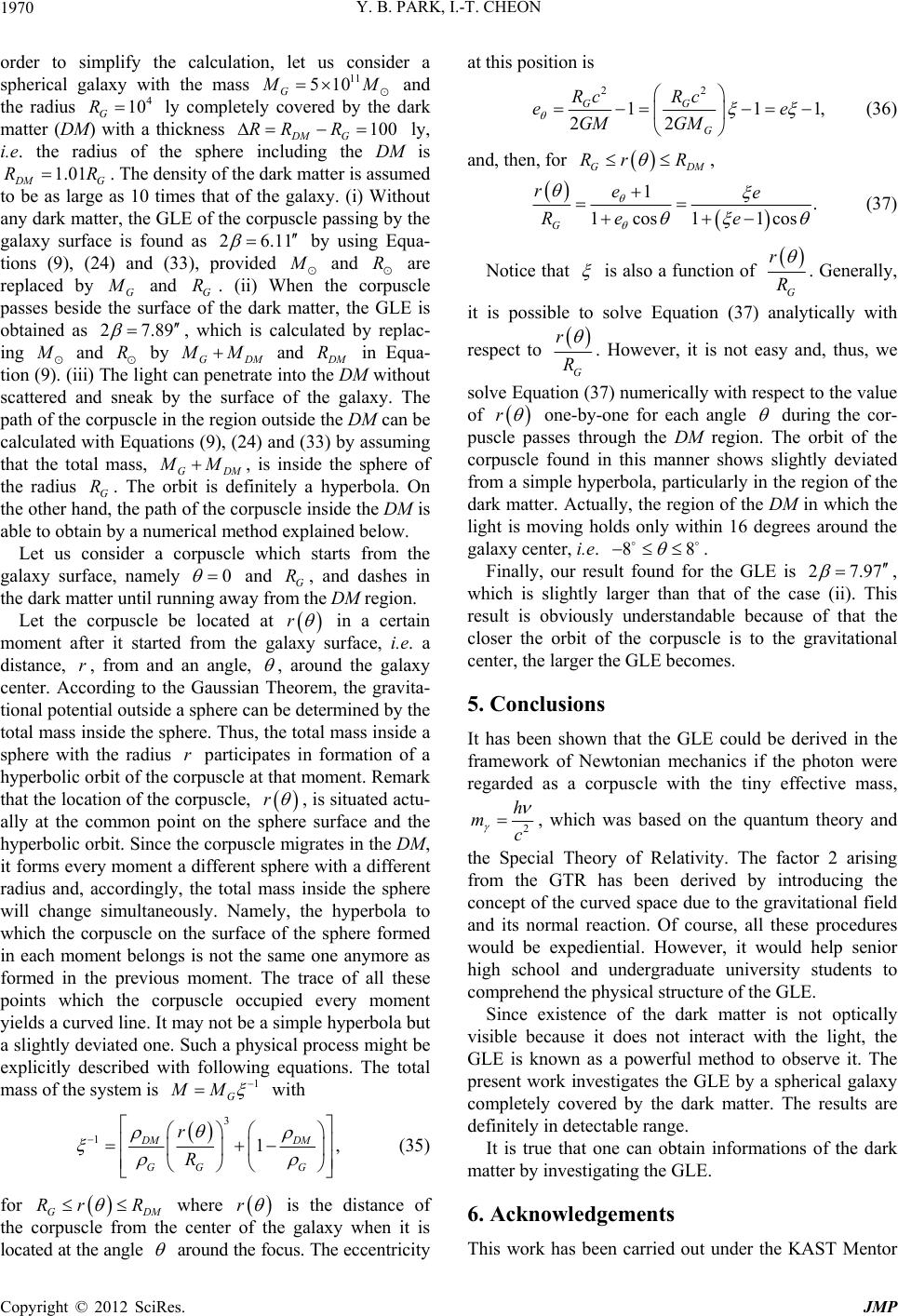
Y. B. PARK, I.-T. CHEON
1970
order to simplify the calculation, let us consider a
spherical galaxy with the mass G11
510
M
10R
100R
and
the radius G ly completely covered by the dark
matter (DM) with a thickness DMG
4
RR
1.01
ly,
i.e. the radius of the sphere including the DM is
MG
. The density of the dark matter is assumed
to be as large as 10 times that of the galaxy. (i) Without
any dark matter, the GLE of the corpuscle passing by the
galaxy surface is found as 26.11
RR
byqua-
tions (9), (24) and (33), provided
using E
and are
aced by G
R
repl
andG. (iihen the corpuscle
passes beside the surface of the dark matter, the GLE is
obtained as 27.8
R) W
9
, which
is calculated by replac-
ing
aR byGDM
nd MM and
M
R inua-
tion (9). (iii) The light can penetrate into the DM without
scattered and sneak by the surface of the galaxy. The
path of the corpuscle in the region outside the DM can be
calculated with Equations (9), (24) and (33) by assuming
that the total mass, GDM
MM the sphere of
the radius G
R. The orbits definitely a hyperbola. On
the other hand, the path of the corpuscle inside the DM is
able to obtain by a numerical method explained below.
Let us consider a
Eq
de
corpuscle which starts from the
ga
, is in
i
si
laxy surface, namely 0
and G
R, and dashes in
the dark matter until runnay frothe DM region.
Let the corpuscle be located at
r
ing awm
in a certain
maxy oment after it started from the galsurface, i.e. a
distance, r, from and an angle,
, around the galaxy
center. According to the Gaussian heorem, the gravita-
tional potential outside a sphere can be determined by the
total mass inside the sphere. Thus, the total mass inside a
sphere with the radius r participates in formation of a
hyperbolic orbit of the corpuscle at that moment. Remark
that the location of the corpuscle,
r
T
, is situated actu-
ally at the common point on the sphere surface and the
hyperbolic orbit. Since the corpuscle migrates in the DM,
it forms every moment a different sphere with a different
radius and, accordingly, the total mass inside the sphere
will change simultaneously. Namely, the hyperbola to
which the corpuscle on the surface of the sphere formed
in each moment belongs is not the same one anymore as
formed in the previous moment. The trace of all these
points which the corpuscle occupied every moment
yields a curved line. It may not be a simple hyperbola but
a slightly deviated one. Such a physical process might be
explicitly described with following equations. The total
mass of the system is 1
G
MM
with
3
1DM
GG
r
R
1,
DM
G
(35)
M
Rr
where
r
for GD
R
is the distance of
uscle of ththe e center e galaxy when it is
located at the angle
corpfrom th
around the focus. The eccentricity
at this position is
22
Rc 111,
22
GG
G
Rc
ee
GM GM
(36)
and, then, for
GDM
Rr R
,
1.
1cos11cos
G
ee
Re e
r
(37)
Notice that
is also a function of
G
r
R
. Generally,
it is possible to solve Equation (37) analytically with
respect to
G
R
r
. However, it is not easy and, thus, we
solve Equation (37) numerically with respect to the value
of
r
one-by-one for each angle
during the cor-
puscle passes through the DM regionThe orbit of the
corpuscle found in this manner shows slightly deviated
from a simple hyperbola, particularly in the region of the
dark matter. Actually, the region of the DM in which the
light is moving holds only within 16 degrees around the
galaxy center, i.e. 88
.
.
Finally, our result found for the GLE is 27.97
,
whi
5. Conclusions
that the GLE could be derived in the
hich is slightly larger than that of the case (ii). Ts
result is obviously understandable because of that the
closer the orbit of the corpuscle is to the gravitational
center, the larger the GLE becomes.
It has been shown
framework of Newtonian mechanics if the photon were
regarded as a corpuscle with the tiny effective mass,
2
c
h
m
, which was based on the quantum theory and
the Special T
optically
vi
informations of the dark
m
6. Acknowledgements
ut under the KAST Mentor
heory of Relativity. The factor 2 arising
from the GTR has been derived by introducing the
concept of the curved space due to the gravitational field
and its normal reaction. Of course, all these procedures
would be expediential. However, it would help senior
high school and undergraduate university students to
comprehend the physical structure of the GLE.
Since existence of the dark matter is not
sible because it does not interact with the light, the
GLE is known as a powerful method to observe it. The
present work investigates the GLE by a spherical galaxy
completely covered by the dark matter. The results are
definitely in detectable range.
It is true that one can obtain
atter by investigating the GLE.
This work has been carried o
Copyright © 2012 SciRes. JMP